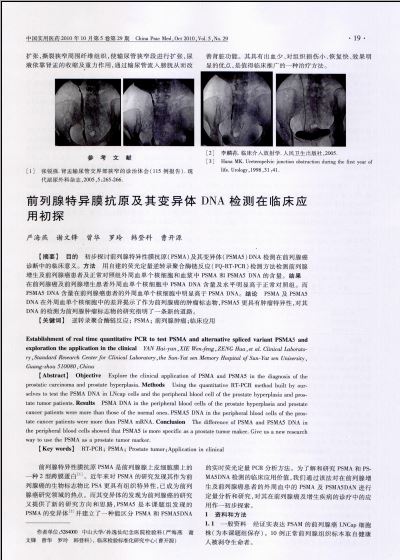前列腺特异膜抗原及其变异体DNA检测在临床应用初探(1)
 |
| 第1页 |
参见附件(1395KB,2页)。
【摘要】 目的 初步探讨前列腺特异性膜抗原(PSMA)及其变异体(PSMA5)DNA检测在前列腺癌诊断中的临床意义。方法 用自建的荧光定量逆转录聚合酶链反应(FQ-RT-PCR)检测方法检测前列腺增生及前列腺癌患者及正常对照组外周血单个核细胞和血浆中PSMA和PSMA5 DNA的含量。结果 在前列腺癌及前列腺增生患者外周血单个核细胞中PSMA DNA含量及水平明显高于正常对照组。而PSMA5 DNA含量在前列腺癌患者的外周血单个核细胞中明显高于PSMA DNA。结论 PSMA及PSMA5 DNA在外周血单个核细胞中的差异提示了作为前列腺癌的肿瘤标志物,PSMA5更具有肿瘤特异性,对其DNA的检测为前列腺肿瘤标志物的研究指明了一条新的道路。
【关键词】逆转录聚合酶链反应; PSMA; 前列腺肿瘤;临床应用
Establishment of real time quantitative PCR to test PSMA and alternative spliced variant PSMA5 and exploration the application in the clinical
YAN Hai-yan,XIE Wen-feng,ZENG Hua,et al.Clinical Laboratory,Standard Research Center for Clinical Laboratory,the Sun-Yat sen Memory Hospital of Sun-Yat sen University,Guang-zhou 510080,China
【Abstract】 Objective Explore the clinical application of PSMA and PSMA5 in the diagnosis of the prostatic carcinoma and prostate hyperplasia.Methods Using the quantitative RT-PCR method built by ourselves to test the PSMA DNA in LNcap cells andthe peripheral blood cell of the prostate hyperplasia and prostate tumor patients.Results PSMA DNA in the peripheral blood cells of the prostate hyperplasia and prostate cancer patients were more than those of the normal ones.PSMA5 DNA in the peripheral blood cells of the prostate cancer patients were more than PSMA mRNA.Conclusion The difference of PSMA and PSMA5 DNAin the peripheral blood cells showed that PSMA5 is more specific as a prostate tumor maker.Give us a new research wayto use the PSMA as a prostate tumor marker.
【Key words】RT-PCR; PSMA; Prostate tumor;Application in clinical
前列腺特异性膜抗原PSMA是前列腺腺上皮细胞膜上的一种2型跨膜蛋白[1]。近年来对PSMA的研究发现其作为前列腺癌的生物标志物比PSA更具有组织特异性,已成为前列腺癌研究领域的热点。而其变异体的发现为前列腺癌的研究又提供了新的研究方向和思路,PSMA5是本课题组发现的PSMA的变异体[2]并建立了一种能区分PSMA和PSMA5DNA的实时荧光定量PCR分析方法。为了解和研究PSMA和PSMA5DNA检测的临床应用价值,我们通过该法对在前列腺增生及前列腺癌患者的外周血中的PSMA及PSMA5DAN进行定量分析和研究,对其在前列腺癌及增生疾病的诊疗中的应用作一初步探索。
1 资料和方法
1.1 一般资料 经证实表达PSAM的前列腺癌LNCap细胞株(为本课题组保存)。10例正常前列腺组织标本取自健康人被剥夺生命者。
1.1.1 标本的采集与保存 10例正常外周血标本取自健康体检者,均为男性,年龄范围23~55岁,平均(34±12)岁。血液标本采用内有20~30 u/ml浓度的肝素抗凝的一次性真空抽血管,抽取患者空腹全血3 ml,于3 h内分离单个核细胞,采用常规的单个核细胞分离方法,置于无RNase的EP管内,然后放-80℃冰箱保存 ......
您现在查看是摘要介绍页,详见PDF附件(1395KB,2页)。